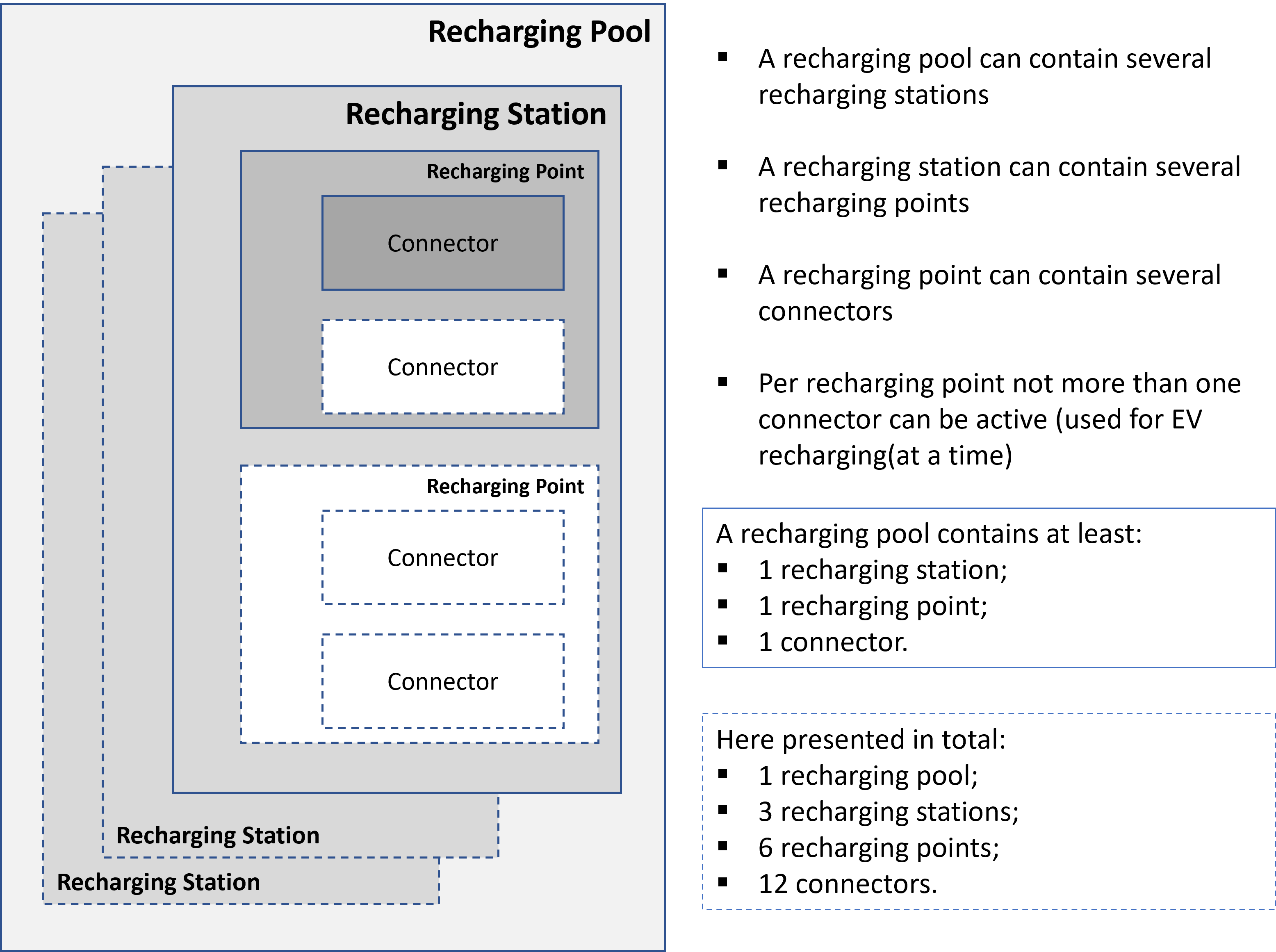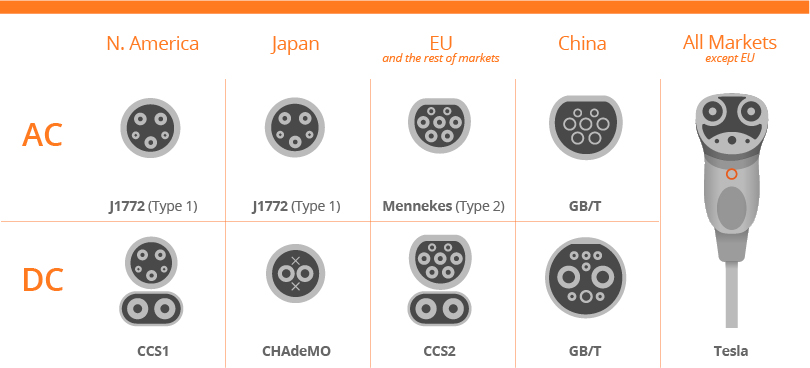Recharging electric vehicles is relatively new and technology develops in a rapid pace. As a result, lots of different terms and definitions are used, often referring to the same phenomenon. This page enables the reader to familiarize with the relevant terms. These terms are grouped per theme. This page aims to give clear definitions and explanations on relevant aspects of electric vehicle charging.
Recharging pool, -station, -point, connector
The EU - Sustainable Transport Forum gives the following definitions providing us the starting point of this publication.

Recharging Pool
A recharging pool consists of one or more recharging stations at a specific location, including, as the case may be, the dedicated parking places adjacent to them. The recharging pool is operated by one charge point operator (CPO) at one location/address and GPS coordinates. The recharging pool is an object relevant for “cartographic view”, guiding tools and all features that represent a recharging infrastructure element on a map. A recharging pool is defined by: One location/address and GPS coordinates; One charge point operator.
Article 2 (51)
| ‘recharging pool’ means one or more recharging stations at a specific location; |
Recharging Station / Recharging Pole / Recharging Dock / Electric Vehicle Charging Station (EVCS)
A Reharging Station is a physical object with one or more recharging points, sharing a common user identification interface. All the physical “human-machine” interfaces are located at the recharging station. Some recharging stations have a badge / RFID reader, buttons, displays, LEDs. Other stations are ‘Plug & Charge’, without buttons, display, etc. In those cases, a vehicle is automatically identified. A recharging station is defined by: One physical object; One user interface.
Article 2 (52)
| ‘recharging station’ means a physical installation at a specific location, consisting of one or more recharging points; |
Recharging Point / Recharging Position / Electric Vehicle Supply Equipment (EVSE)
The electric energy is delivered through a recharging point. A recharging point may have one or several connectors (outlets or plugs) to accommodate different connector types. Only one can be used at the same time. A recharging point is defined by: Recharging one vehicle at a time. In other words: per recharging station the number of recharging points and (dedicated) parking spots are equal.
Article 2 (50)
| ‘recharging point, station or pool dedicated to heavy-duty vehicles’ means a recharging point, station or pool intended for the recharging of heavy-duty vehicles, either due to the specific design of the connectors/plugs or to the design of the parking space adjacent to the recharging point, station or pool, or both; |
Connector
A connector is the physical interface between the recharging station and the electric vehicle through which the electric energy is delivered:
- A plug on a cable (one side consists of a ‘male’ plug and the other side of the ‘female version’). The plug of one side of the cable fits into the outlet of the recharging point and the plug on the other side of the cable fits into the inlet on the vehicle.
- A plug attached on an inseparable cable of the recharging station (common for fast recharging stations). This plug fits in the inlet of the vehicle.
- An induction plate.
- A pantograph.
Article 2 (12)
| ‘connector’ means the physical interface between the recharging or refuelling point and the vehicle through which the fuel or electric energy is exchanged; |
Usually, the number of recharging points and the number of connectors is equal, but not always. For example, there are recharging stations consisting of 2 recharging points and 3 connectors. In that case not more than 2 connectors can be used, no more than 2 vehicles can be charged at a time (one AC and the other DC).
Source: AFIR, Electric vehicle charging. Definitions and explanation (2019)
The access type of the recharging stations
Currently, EAFO counts all types of publicly accessible recharging infrastructure.
Recharging modes based on power output
In the European Union, recharging points are classified into two main categories, based on their power output and speed. Category 1 is recharging via AC, while Category 2 is recharging via DC.
Recharging point categories based on AFIR (Annex III)
| Category | Sub-category | Maximum power output | Definition pursuant to Article 2 of AFIR |
|---|---|---|---|
| Category 1 (AC) | Slow AC rechargingpoint, single-phase | P < 7.4 kW | Normal-power recharging point |
| Medium-speed AC rechargingpoint, triple-phase | 7,4 kW ≤ P ≤ 22 kW | ||
| Fast AC rechargingpoint, triple-phase | P > 22 kW | ||
| Category 2 (DC) | Slow DC recharging point | P < 50 kW | High-power recharging point |
| Fast DC recharging point | 50 kW ≤ P < 150 kW | ||
| Level 1 - Ultra-fast DC recharging point | 150 kW ≤ P < 350 kW | ||
| Level 2 - Ultra-fast DC recharging point | P ≥ 350 kW |
Types of EV recharging connectors (plugs)
To date, not all battery electric vehicles and plug-in hybrid electric vehicles can recharge at every recharging point in the world. This is because the EV recharging connector and vehicle inlet vary across geographies and models.
Europe
For the EU, the Alternative Fuels Infrastructure Directive 2019/94/EU (AFID) currently requires that all recharging points are, for interoperability purposes, equipped at least with socket outlets or vehicle connectors of Type 2, Mennekes (for AC normal and high power recharging points), and connectors of the combined charging system, CCS/Combo 2 (for DC high power recharging points). The figure below provides an illustrated overview of these requirements:
Source: CharIN
At the same time, AFID does not prohibit the addition of other connectors to a recharging point. While prior to the adoption of AFID, a number of recharging points with AC connectors other than Type 2 were deployed in the EU, the prescription of the Type 2 standard through the Directive put an end to this. Similarly, while it has for some time been market practice to equip in particular 50 kW recharging points with an additional CHAdeMO connector, more and more providers of high power recharging points choose to equip their stations with CCS/Combo 2 connectors only.
Rest of world – other standards
SAE J1772 and J3068 (North-America, Japan)
The Society of Automobile Engineers (SAE) has developed the J1772 and J3068 connector standards. They are mostly applied in the North-American markets, while J1772 is also used in Japan for AC recharging purposes.
SAE J1772 (IEC 62196 Type 1) defines four levels of single-phase recharging: AC Level 1, AC Level 2, DC Level 1, and DC Level 2. Although the SAE J1772 CCS connector for DC recharging is quite similar (though slightly different) from the EU CCS connector, the AC J1772 connector is entirely different. This is largely due to the fact that the electricity is commonly supplied at 120 volts in the US, compared to 230V in Europe.
SAE J3068 complements SAE J1772 with solutions for three-phase recharging. The J3068 connector is mechanically identical to the Type 2 connector, and is based on the IEC 62196-2 and -3 standards.
CHAdeMO (Japan)
The Japanese utility TEPCO developed CHAdeMo. It is the official Japanese DC recharging standard and virtually all Japanese DC fast recharging stations offer a CHAdeMO connector. In Europe, while it has for some time been market practice to equip in particular 50kW recharging points with an additional CHAdeMO connector, the importance of CHAdeMO is fading. Mainly this is due to the choices by Japanese (but also some French) car manufacturers to increasingly equip their EU market electric vehicles with a CCS inlet.
Tesla (all markets except EU)
Tesla has developed a proprietary standard for its connectors and inlets. The Tesla connector is a unified connector for AC and DC recharging, as it supports all voltage levels. However, since the end of 2018, Tesla vehicles intended for the EU market are supplied with a European CCS inlet, and Tesla is gradually also equipping its European recharging points with EU-type CCS connectors.
GB/T 20234.2 and 20234.3 (China)
Guobiao or in short GB standards are the Chinese national standards. The suffix /T indicates these are recommended (though not mandatory) standards. While GB/T 20234.2 is the Chinese standard for AC recharging connectors, 20234.3 applies to DC recharging connectors. These standards are only supported in China, although there have been discussions between CHAdeMO and the Chinese standardisation organisations to develop a new, common DC recharging connector.
Overview of global connector standards
Legal or recommended standard for each geographical zone

Source: EnelX
Available connectors in each geographical zone
